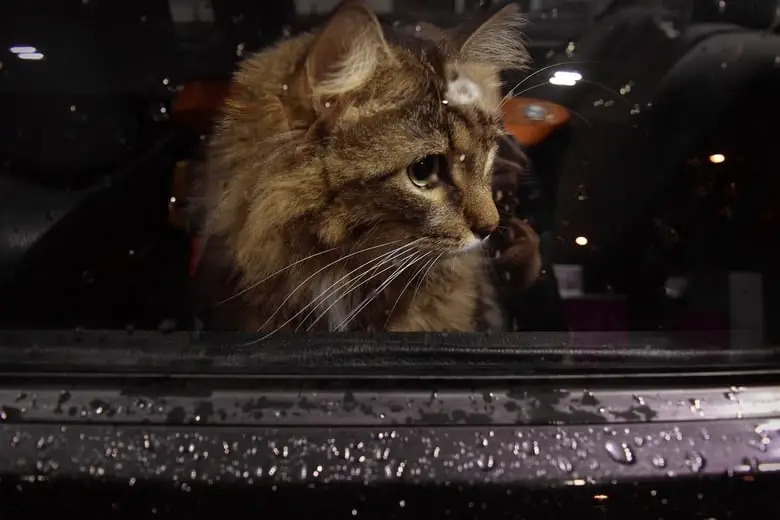It is essential to bring our four-legged friends for trips in the car from time to time, whether we are taking them to the vet, the park, or our new home across the country. Some animals, namely dogs, clearly enjoy riding in cars.
We see them at stoplights, heads sticking out of the passenger-seat windows, mouths agape, having the time of their lives. But how do our feline companions fare when they have to travel? Do cats like riding in cars?
Do Cats Like Riding in Cars?
The vast majority of cats dislike the experience of riding in a car. The unfamiliar environment of a car can trigger a nervous reaction and in some instances a moving vehicle can cause your cat to experience motion sickness.
In addition to that, a significant number of cat owners say that when their cats are required to ride, they express their displeasure through excessive yowling and aggressive behavior such as scratching.
They also frequently become ill from, as we’ve mentioned above, motion sickness. Motion sickness in cats is brought on by anxiety and can make the experience of riding in the car a bad one.
Many cats only ride in the car when they are being taken to the vet, and consequently, learn to associate the experience with a destination that often causes them extreme stress.
Motion sickness in cats is characterized by excessive vocalization, pacing, excessive drooling, licking of lips, lethargy, and of course, vomiting and diarrhea.
Why Don’t Cats Like Riding in Cars?
Cats are creatures of routine. It is important to them to feel safe and secure, and as though the environment they inhabit is their own.
They will observe their owners’ routines and work around them to cohabit instinctively and harmoniously. Your cats’ preference for routine is part of an inborn survival instinct that has evolved over countless generations.
To survive, they had to become hyper-aware of their surroundings and sensitive to any change in the environment that could signal danger.
For a cat who finds safety and comfort in its daily schedule of snacking, napping, stretching, and chasing the mouse-on-a-stick, to be suddenly hauled off in the back of a moving vehicle is a deeply troubling experience.
That said, there are ways to make the experience more tolerable, and maybe even enjoyable, for your fur baby.
How Do I Get My Cat to Like Car Rides?
Traveling with your cat doesn’t have to be a nightmare. There are a variety of ways in which you can prepare your cat and make the prospect of travel far less daunting for everybody involved.

Helping your cat overcome their anxiety around riding in the car will enable you to take them to more places and spend more time together, which is a win-win. One of the first actions you can take is to make your cat feel more comfortable in its carrier.
Experts suggest bringing your carrier out more often at home and placing treats and toys in it to show your cat that it can be an unthreatening, even fun, place.
Once the carrier is established as a safe place, it is helpful to begin taking short car trips with your cat. It is advised to place your cat in their carrier, take them to the car, and simply run the engine for a few minutes.
This will help your cat get used to the noise and vibrations of the car, and make the backseat a more familiar environment. The next step is to begin taking short trips around the block, and finally, to start taking drives of about thirty minutes. And don’t forget, treats go a long way!
Conditioning your cat to be comfortable in a car may take some time, but the reward will be being able to take your cat to necessary appointments and on longer trips without the added stress of their discomfort.

Additionally, there is the option of using a pheromone spray in your cat’s carrier or inside the car to make the environment more welcoming.
Do Cats Need to Be Restrained in a Car?
Cats need to be properly restrained whenever they are inside a moving vehicle, even if you only intend to take them for a short trip.
For a reasonably short ride, a cat backpack may be used. For longer rides, however, a cat needs to be able to stand up, stretch out and turn around to be optimally comfortable. There are many cat carriers on the market that have been crash tested with your cat’s optimal safety in mind.
For cat’s who don’t necessarily need the comfort of their cat carrier, you can utilize a seatbelt harness. As with the carrier option, it is recommended that you spend some time training your cat to feel comfortable in their seatbelt harness at home.
There are other ways of preparing your car to give your cat, and you, the best chance of having a sickness-and-stress-free trip. Having your cat’s favorite toys, pillows, or blanket in the carrier or backseat will imbue the surroundings with a sense of comfort and familiarity.
Being mindful of the temperature and shading the windows from bright light is also helpful. Basically, treat your cat as delicately as you would an elderly, infirm human relative, and they will eventually come to view travel as a less stressful experience!
How Long Can a Cat Travel in a Car?
When traveling with your cat in a car, you should stop to allow them out of their carrier every four to six hours. Take them for a short walk on a cat leash if that’s something you are accustomed to doing together, ensure they use the bathroom, and offer them food and water.
For obvious reasons, you don’t want to risk your cat going on the run in an unfamiliar locale, so always be mindful while doing this. Never leave your cat in the car unattended, even if you are just making a short pit stop.
It can take only 5-10 minutes for cats to become gravely ill or die in extreme heat. Additionally, experts suggest withholding food 12 hours before traveling as this can reduce nausea. Water bottles that hang on the door of your cat’s carrier are strongly recommended.
Conclusion
In summation, the majority of cats strongly dislike the experience of traveling in a car unless they are accustomed to it. Travel takes cats out of the comfort zone they spend much of their life creating within your home, and the experience can cause severe stress and motion sickness.
Thankfully, there are methods to overcome this. Getting your cat used to spending time in their cat carrier and in your vehicle in small increments is a great place to start.
You can also replicate the environment of home inside your car by strategically placing your cat’s accouterments in their carriage or the back seat.

